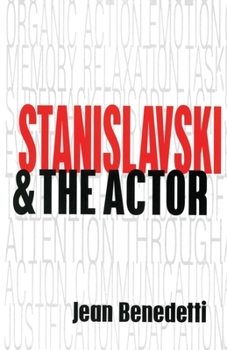Stanislavski and the Actor: The Method of Physical Action
Select Format
Select Condition 
Book Overview
First published in 1999. Routledge is an imprint of Taylor & Francis, an informa company. This description may be from another edition of this product.
Format:Paperback
Language:English
ISBN:0878300902
ISBN13:9780878300907
Release Date:October 1998
Publisher:Routledge
Length:176 Pages
Weight:0.40 lbs.
Dimensions:0.5" x 5.0" x 7.7"
Customer Reviews
1 rating
Easy to Understand, Great Introduction to Stanislavski
Published by Thriftbooks.com User , 23 years ago
Benedetti first outlines Stanislavski's Method of Physical action, a term which Benedetti does not think accurately denotes the idea it represents. He prefers to refer to it as the Method of Analysis through Physical Action because it recognizes that physical movement is not the sole ingredient for good acting. Nonetheless, how an actor moves partly determines how his audience will react. If the movements are believable and comparable to the viewer's own movement, the viewer will be able to identify with the actor's performance. In other words, although acting is a created behavior, it must appear real. Benedetti coins the terms, the "Real I" and the "Dramatic I" to illustrate the difference and the process of creating a character. He notes the actor must "create a Dramatic `I' that will look and sound as human as a Real `I'" (4). The most important factor in making this transition, according to Benedetti, is belief. The actor must believe his situation is true, and his attitude toward his movements and the treatment of other actors and objects will seem true. There are three phases in achieving this goal: (1) I am being, which involves creating past and future character histories for the play along with dividing the play into its thematic parts and exploring the subtext, (2) The Third Being, where the text's structure is examined in the context of its history and the text merges with the actor's experiences and actions, and (3) The Creative Actor in the Play, which refines the actor's performance and cuts superfluous movement. Benedetti then explains Stanislavski's system, or technique, to create the Dramatic `I.' Stanislavski believed in continual practice of exercises to keep the actor's body and voice finely tuned like a musical instrument. Benedetti presents a variety of such exercises that attempt to break movements into their smallest parts, thereby making the actor acutely aware of how his body works. These exercises later translate into the components of dramatic action. For example, if an actor was supposed to place a candle down (like Jim in The Glass Menagerie scene with Laura), he would not just simply bend over and put the candle on the ground. The actor might first look around for a suitable place, set the candle down, then adjust its position to prevent the wax from dripping. The exercises for mental action are perhaps the most important for creating the belief necessary to create the Dramatic `I.' How an actor focuses his senses and concentrates on his surroundings is essential to a believable performance. The mechanics of focus and concentration are similar to the mechanics of movement, and Stanislavski encourages actors to dissect this as well. Understanding how one achieves this in reality also simplifies the process of creating an imaginary world for the actor. The actor imagines his character's past, present, and future memories along with much of his physical setting. With a trained imagination, Sta





